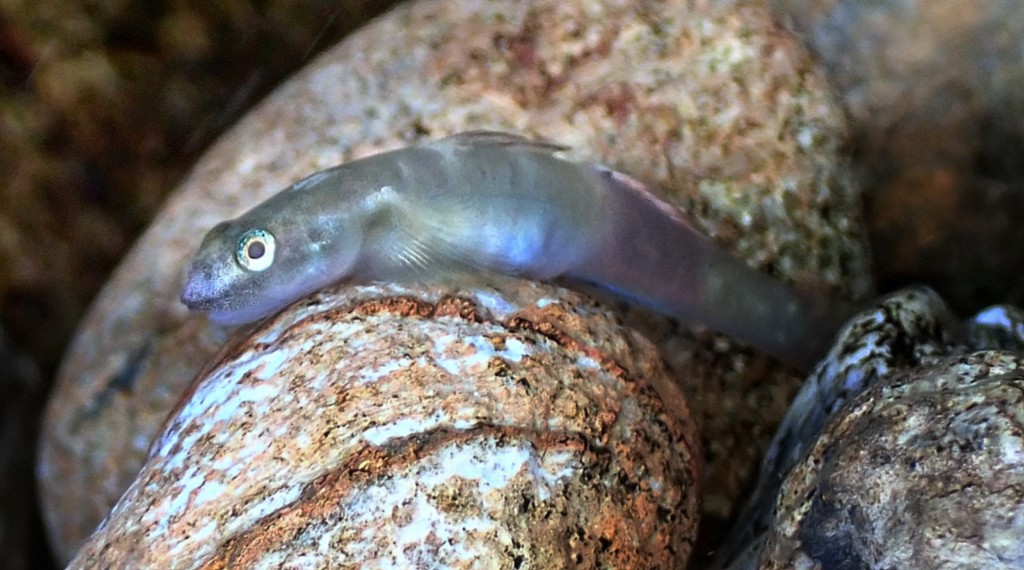LENTIPES KAAEA - (WATSON, KEITH & MARQUET, 2002)
Picture courtesy of: Amaury Durbano
Actinopterygii (Gigaclass) > Actinopteri (Class) > Teleostei (Subclass) > Gobiiformes (Order) > Gobioidei (Suborder) > Oxudercidae (Family) > Sicydiinae (Subfamily) > Lentipes (Genus)
Nez rouge calédonien, Caledonian red-nose,
Synonyme
Lentipes solomonensis (Jenkins, Allen & Boseto, 2008)
---------------------
Description
Dorsal spines (total): 7, membrane on first dorsal fin not touching base of second dorsal fin, spines not filamentous; Dorsal soft rays (total): 9-10 (usually: 10); Anal spine: 1; Anal soft rays: 9-10 (usually: 10) and directly opposite to second dorsal fin; Pectoral fins rays: 17-18 (usually: 17). Slightly flexible tricuspid teeth in upper jaw, males with recurved canine like teeth in upper and lower jaws, females usually without conical teeth in upper or lower jaws. Max. length: 5.0 cm SL (male), 4.3 cm SL (female). Depth range: 0 - 5 m.
Color
Females: Tan to brownish. Head and body dusky laterally being darkest midlaterally on caudal peduncle, an irregular lateral band sometimes present, above midline some dusky bars and bands may be present, dorsally few dusky square shaped saddles may be present. Opercle with a blackish triangular patch. Blackish spot medially at base of caudal fin may be absent in some specimens. Dorsal rays and spines dusky, membrane and rays distally without pigment. Caudal fin rays dusky, membrane and distal margin without pigment. Anal fin with blackish pigmentation at base of rays and spine, remainder not pigmented. Pelvic disc not pigmented. Pectoral rays and membrane dusky. Pectoral base dusky with a medial blackish blotch.
Males: with snout, upper lip, second dorsal fin, and area between second dorsal and anal fins bright red to purplish; Second dorsal fin with a black spot adjacent to ray 1 medially, red usually not touching spot; Anal fin usually reddish basally bluish distally; A pair of lobes associated with urogenital papilla, paired lobes adjacent to urogenital apparent only in gravid material.
Etymology
Lentipes: from Latin, lens, lentis = slow + from Latin, pes = foot. Referring to ventral fins, which are united to form a semicircular disk adherent to the belly.
kaaea: the new species is named for the Napwé Tribal Chief Kaaea who kindly permitted collection of freshwater fishes on tribal lands. Kaaea is a name used in Melanesia and throughout Polynesia, to include Hawaii the type locality for Lentipes, and is used here to exemplify the broad distribution of Lentipes.
Original description: Lentipes kaaea Watson, Keith & Marquet 2002 - Type locality: Napwé Imié above dam south of Napwéimiê near Poindimié, North Province, New Caledonia; 13 Nov. 1997, G. Marquet and J.C. Guéry.
Distribution
Southwestern Pacific: New Caledonia, Vanuatu, Solomon Islands and Fiji.
Biology
Occurs in swift clear high gradient streams with slab and boulder strewn bottom, some course gravel may be present. Observed swimming in strong currents rather than being attached to rock surface like other species of Sycidiinae in the environment.
Last update: 3, November 2024
Actinopterygii (Gigaclass) > Actinopteri (Class) > Teleostei (Subclass) > Gobiiformes (Order) > Gobioidei (Suborder) > Oxudercidae (Family) > Sicydiinae (Subfamily) > Lentipes (Genus)
Nez rouge calédonien, Caledonian red-nose,
Synonyme
Lentipes solomonensis (Jenkins, Allen & Boseto, 2008)
---------------------
Description
Dorsal spines (total): 7, membrane on first dorsal fin not touching base of second dorsal fin, spines not filamentous; Dorsal soft rays (total): 9-10 (usually: 10); Anal spine: 1; Anal soft rays: 9-10 (usually: 10) and directly opposite to second dorsal fin; Pectoral fins rays: 17-18 (usually: 17). Slightly flexible tricuspid teeth in upper jaw, males with recurved canine like teeth in upper and lower jaws, females usually without conical teeth in upper or lower jaws. Max. length: 5.0 cm SL (male), 4.3 cm SL (female). Depth range: 0 - 5 m.
Color
Females: Tan to brownish. Head and body dusky laterally being darkest midlaterally on caudal peduncle, an irregular lateral band sometimes present, above midline some dusky bars and bands may be present, dorsally few dusky square shaped saddles may be present. Opercle with a blackish triangular patch. Blackish spot medially at base of caudal fin may be absent in some specimens. Dorsal rays and spines dusky, membrane and rays distally without pigment. Caudal fin rays dusky, membrane and distal margin without pigment. Anal fin with blackish pigmentation at base of rays and spine, remainder not pigmented. Pelvic disc not pigmented. Pectoral rays and membrane dusky. Pectoral base dusky with a medial blackish blotch.
Males: with snout, upper lip, second dorsal fin, and area between second dorsal and anal fins bright red to purplish; Second dorsal fin with a black spot adjacent to ray 1 medially, red usually not touching spot; Anal fin usually reddish basally bluish distally; A pair of lobes associated with urogenital papilla, paired lobes adjacent to urogenital apparent only in gravid material.
Etymology
Lentipes: from Latin, lens, lentis = slow + from Latin, pes = foot. Referring to ventral fins, which are united to form a semicircular disk adherent to the belly.
kaaea: the new species is named for the Napwé Tribal Chief Kaaea who kindly permitted collection of freshwater fishes on tribal lands. Kaaea is a name used in Melanesia and throughout Polynesia, to include Hawaii the type locality for Lentipes, and is used here to exemplify the broad distribution of Lentipes.
Original description: Lentipes kaaea Watson, Keith & Marquet 2002 - Type locality: Napwé Imié above dam south of Napwéimiê near Poindimié, North Province, New Caledonia; 13 Nov. 1997, G. Marquet and J.C. Guéry.
Distribution
Southwestern Pacific: New Caledonia, Vanuatu, Solomon Islands and Fiji.
Biology
Occurs in swift clear high gradient streams with slab and boulder strewn bottom, some course gravel may be present. Observed swimming in strong currents rather than being attached to rock surface like other species of Sycidiinae in the environment.
Last update: 3, November 2024
